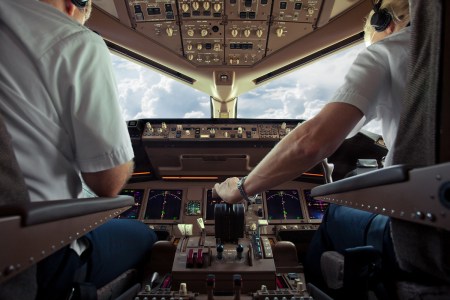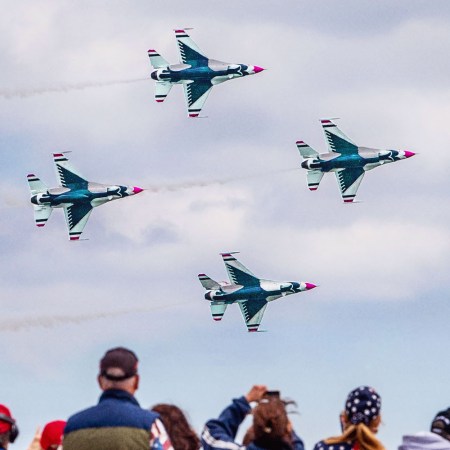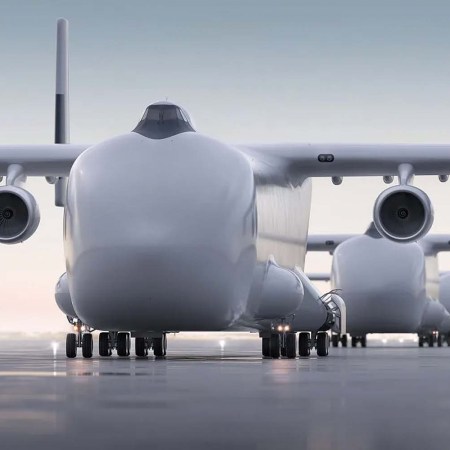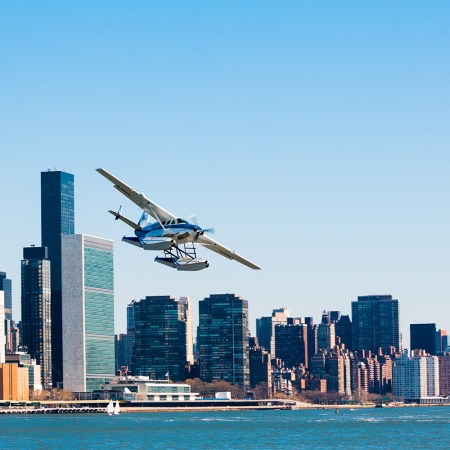David Richardson has not been able to talk about his work for the last 25 years. As the director of air vehicle design and technology at Lockheed Martin Aeronautics, he’s been involved with the company’s Skunk Works laboratory and its highly secret “black” projects. But he’s finally free to chat as he’s now heading up Quesst, a NASA mission exploring the future of supersonic passenger flight through its experimental X-59 aircraft.
“It is weird for me to see it all over the internet,” Richardson admits. Lockheed Martin and NASA unveiled the X-59 earlier this year. In May, they conducted a flight readiness review, a necessary step towards official approval. Its debut flight is expected later this year.
These two engineering giants are hardly alone: A new age of supersonic travel is taking shape throughout the industry, with startups also getting in on the action. In March, Boom Supersonic, based out of Colorado, completed the first test flight of its XB-1, a demonstrator aircraft and the first independently developed supersonic jet. Major airlines like American and United have already placed orders for the aircraft, named Overture, that they hope will eventually materialize. Meanwhile, Spike Aerospace, based near Boston, is developing a supersonic business jet.
Given the current impatient culture of on-demand, instant access, now-now-nowness, the case for getting to places — or getting cargo to places — faster might seem an obvious one. “Some business is very time-sensitive, sometimes business meetings have to be in-person and sometimes lost time is lost efficiency,” argues Richardson. “Some business travelers will be happy to pay extra just because they’re over all the traveling they have to do. For the traveling public, [supersonic flight] would be very expensive but worth it if you save a day getting to your vacation.”
Excitement at the idea of flying from LAX to Tokyo in four hours, or anywhere around the globe in roughly half the time it takes now, sounds a little strange considering that this is not a new idea at all. Concorde, the elegant supersonic airliner which marks the 55th anniversary of its maiden flight this year, flew between New York and London or Paris in around three hours. At least it did for 27 years.
“It was an amazing aircraft, but think it got ahead of what we could do [with supersonic flight] reasonably and in a practical manner, and since then other pressures and challenges [on commercial supersonic flight] have increased,” says Peter Coen, Quesst’s mission integration manager at NASA. “Concorde put on a good sprint but couldn’t last the marathon.”

It was then mothballed. This was in part thanks to an oil crisis, a drive in the airline industry towards cheaper options and Concorde becoming too expensive to run. That, notes Vik Kachoria, CEO and founder of Spike Aerospace, is a worry to these new supersonic projects even now: rising fuel prices would make their business case challenging once again.
But it wasn’t just the bottom line that was problematic; odd as it may be, it was the sound Concorde made. When an aircraft approaches the speed of sound — at 767 mph — pressure disturbances build up in waves around it and, rather than pass around the fuselage sequentially as they might at sub-sonic speeds, begin to bunch up together. Collectively, these compressed waves produce the sonic boom, a noise loud enough to shake the crockery and scare the horses at ground level.
That wasn’t a problem over water, but first the U.S., and then other nations, banned the sonic boom over land — and when 80% of flights are over land, that’s a killer blow. Could Concorde really be justified only flying a transatlantic route? Maybe, if the fuel is cheap enough; that’s going to be Boom’s model.
But then what was the point of a supersonic aircraft that had to fly at sub-sonic speeds much of the time? It was, as Richardson puts it, “like having a Ferrari tow a 40-foot trailer in second gear.” He argues that, then and now, there isn’t much advantage in offering passengers the chance to fly a bit faster than normal, while flying at Mach 2 or more (that’s twice the speed of sound) poses a fundamental change in economics and engineering. The sweet spot is somewhere between Mach 1.6 and 1.8.

Taming the Sonic Boom
The sonic boom problem has been a major stumbling block to the return of commercial supersonic travel.
“It’s not going to cause earthquakes or disrupt the flight of other aircraft, but it really is a very loud and disruptive sound,” Coen emphasizes. “I think people were [once] willing to accept the impact of technology that didn’t [positively] affect their own lives, but I think attitudes have since changed. Look at the way attitudes to the takeoff and landing noise at airports have changed.”
He cites an experiment 60 years ago when the U.S. government bombarded Oklahoma City with eight sonic booms a day, every day, for six months. The residents were expected to be open-minded about the booms — an aeronautical center was a major local employer, and there was Tinker Air Force Base nearby. But the experiment was cut short in the wake of complaints about broken windows. That said, three-quarters of survey respondents reckoned they could live with the booms indefinitely. The quarter who couldn’t were enough to see the proposed supersonic Boeing 2707 project canceled.
We’ve seen every other technology go forward, get better and more incredible, and yet aviation has been stuck in the same place for 60 years.
Vik Kachoria, CEO and founder of Spike Aerospace
Yet while the essential physics of what’s called “low boom” have been understood for half a century — flying at supersonic speeds while producing a quieter sonic boom; it’s believed that eradicating the noise altogether may be impossible — finding and then testing a solution has proved exceedingly difficult.
That’s until a more recent development: not necessarily of new materials, though they’re part of the design updates, but accessible supercomputing. “That’s allowed for much faster [design] iterations so we can now do in months what previously may have taken years,” Richardson explains. It’s also allowed startups to participate in a field that would, not long ago, have been the exclusive realm of government agencies.
In other words, the low-boom solution “is all done through the shaping of the aircraft,” as Coen says, which is similar across all of the aircraft now being developed: sharp angles, specific tail surface arrangements, engines placed far back along a long, narrow fuselage and an extra long nose. This encourages air pressure to build up and dissipate as a series of evenly spaced pulses — or mini booms — rather than collectively as one big bang.
That’s one reason why Spike is aiming at a business-size jet, as the proportions are more amenable to this distinctive shape. There would still be a sound heard at ground level but, as Kachoria describes it, one more akin to a car door being slammed from 50 feet away.

Not “Just for Billionaires”
The boom is not the only stumbling block as supersonic travel looks to make a comeback. Aviation regulators need to be won around — and in light of recent mishaps for Boeing, which had its own Sonic Cruiser project in the early 2000s, they’re understandably on edge. The expectation is that the legislation prohibiting sonic booms over land will be revised towards the end of this decade.
As supersonic aircraft burn more fuel, there’s also the environmental impact, marginal perhaps with only a few planes flying, but not so minimal should supersonic flight really take off (and with air travel expected to account for 12% of global emissions soon enough as it is). Coen says there’s no reason why they can’t run on the SAFs, or sustainable aviation fuels, that are now being developed, with careful evaluation of the best way to fly (routing, altitude, etc.) also mitigating impact.
“But it’s incumbent on us to make sure everything is in place,” Boom Supersonic CEO Blake Scholl argues. “People tend to think of Concorde as the epitome of unsustainability, but half a century on we can do things now they couldn’t do then. We can make supersonic passenger flight more sustainable than the passenger aircraft flying today. We’ve had the opportunity to build a new aircraft from the ground up.”
The Good and Bad News About the Future of Turbulence
Buckle up, because it’s becoming more frequent. Thankfully, we’re getting better at detecting it, too.Richardson argues that it’s more a framing problem: the need to counter the gut feeling many have that supersonic flight is just for the elite. As he points out, this was previously the case with cell phones. It was the wealthy’s early uptake of the cell phone that, over time, allowed costs to be driven down such that the technology became available to everyone. And there’s an even more apt comparison in his mind.
“Commercial jet travel was very expensive in the 1950s and became cheaper and more accessible over time [too],” he says, “and the same will happen for supersonic flight.”
Kachoria agrees. He doesn’t see the new era of supersonic travel being “just for billionaires.” He views it, initially, as a replacement for the first-class cabin on normal airliners, with 16 to 20 passengers flying “supersonic class.” They get to save time while airlines get to differentiate themselves from the competition, while being able to carry more people on sub-sonic flights.
After all, the current commercial model is dominated by the idea of moving as many people as efficiently and cheaply as possible around the world. That explains the advent of money-printing super-sized aircraft like the Airbus A380. Future airliner development is likely to be limited to improving efficiency, and thus profits for the airlines.
According to Kachoria, that leaves it down to the small, fledgling supersonic industry to push commercial flight into the future. “We’ve seen every other technology go forward, get better and more incredible, and yet aviation has been stuck in the same place for 60 years,” he laments.

Eyes on the Future Beyond Supersonic
To make that technological leap, there’s one more wrench in the works. While new supersonic designs are promising when it comes to addressing the boom problem, that’s just a first step. After that will come the necessary development of the right engines, specifically smaller-diameter turbojets. The technology already exists, it’s the cost that’s the issue. “Engines take a huge amount of investment and years of work,” says Richardson. “What we’re talking about developing here is really not easy.”
That’s why he takes a measured skepticism towards the notion that a supersonic passenger aircraft will come about through the efforts of any one startup alone. “It’s just hard to see any one startup being able to get the right level of investment,” he suggests. “Engine development is more something that will require national investment.” Aerion, another fledgling company that was working on a small supersonic business jet, folded back in 2021 precisely because of lack of funds; this was despite having $11 billion in pre-orders from the likes of NetJets as well as investment from Boeing.
While Kachoria sees the reintroduction of supersonic passenger flight as a small stepping stone on the road to more ambitious travel goals — space planes, for example, and the ability to fly anywhere on the planet in 90 minutes; he laughs when he concedes that he’s a big fan of science fiction — Richardson for one is downplaying any discussion that supersonic commercial flight is already old news, and that actually hypersonic is where it’s at.
“A lot of people are already talking about hypersonic flight, but it’s an enormous step to get there and would require billions of dollars of investment,” he says. “We have to take [all this] one step at a time. It’s an evolution.”
Given the engineering and regulatory hurdles yet to cross, Richardson doesn’t expect supersonic commercial aircraft to be in operation much before the late 2030s.
But, he says, it is definitely coming.
This article was featured in the InsideHook newsletter. Sign up now.

























